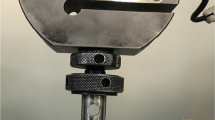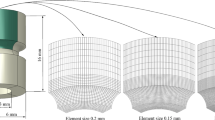Abstract
The integrity of articular cartilage depends on the proper functioning and mechanical stimulation of chondrocytes, the cells that synthesize extracellular matrix and maintain tissue health. The biosynthetic activity of chondrocytes is influenced by genetic factors, environmental influences, extracellular matrix composition, and mechanical factors. The mechanical environment of chondrocytes is believed to be an important determinant for joint health, and chondrocyte deformation in response to mechanical loading is speculated to be an important regulator of metabolic activity. In previous studies of chondrocyte deformation, articular cartilage was described as a biphasic material consisting of a homogeneous, isotropic, linearly elastic solid phase, and an inviscid fluid phase. However, articular cartilage is known to be anisotropic and inhomogeneous across its depth. Therefore, isotropic and homogeneous models cannot make appropriate predictions for tissue and cell stresses and strains. Here, we modelled articular cartilage as a transversely isotropic, inhomogeneous (TI) material in which the anisotropy and inhomogeneity arose naturally from the microstructure of the depth-dependent collagen fibril orientation and volumetric fraction, as well as the chondrocyte shape and volumetric fraction. The purpose of this study was to analyse the deformation behaviour of chondrocytes using the TI model of articular cartilage. In order to evaluate our model against experimental results, we simulated indentation and unconfined compression tests for nominal compressions of 15%. Chondrocyte deformations were analysed as a function of location within the tissue. The TI model predicted a non-uniform behaviour across tissue depth: in indentation testing, cell height decreased by 43% in the superficial zone and between 11 and 29% in the deep zone. In unconfined compression testing, cell height decreased by 32% in the superficial zone, 25% in the middle, and 18% in the deep zones. This predicted non-uniformity is in agreement with experimental studies. The novelty of this study is the use of a cartilage material model accounting for the intrinsic inhomogeneity and anisotropy of cartilage caused by its microstructure.
Similar content being viewed by others
References
Athanasiou KA, Rosenwasser MP, Buckwalter JA, Malinin TI, Mow VC (1991) Interspecies comparisons in in situ intrinsic mechanical properties of distal cartilage. J Orthop Res 9:330–340
Bachrach NM, Valhmu WB, Stazzone E, Ratcliffe A, Lai WM, Mow VC (1995) Changes in proteoglycan synthesis of chondrocytes are associated with the time-dependent changes in their mechanical environment. J Biomech 28:1561–1569
Baer AE, Laursen TA, Guilak F, Setton LA (2003) The micromechanical environment of intervertebral disc cells determined by a finite deformation, anisotropic, and biphasic finite element model. J Biomech Eng 125:1–11
Buschmann MD, Gluzband YA, Grodzinsky AJ, Hunziker EB (1995) Mechanical compression modulates matrix biosynthesis in chondrocyte/agarose culture. J Cell Sci 108:1497–1508
Clark AL, Barclay LD, Matyas JR, Herzog W (2003) In situ chondrocyte deformation with physiological compression of the feline patellofemoral joint. J Biomech 36:553–568
Farquhar T, Dawson PR, Torzilli PA (1990) A microstructural model for the anisotropic drained stiffness of articular cartilage. J Biomech Eng 112:414–425
Federico S, Herzog W, Wu JZ, La Rosa G (2004a) A method to estimate the elastic properties of the extracellular matrix of articular cartilage. J Biomech 37:401–404
Federico S, Grillo A, Herzog W (2004b) A transversely isotropic composite with a statistical distribution of spheroidal inclusions: a geometrical approach to overall properties. J Mech Phys Solids 52(10):2309–2327
Federico S, Grillo A, La Rosa G, Giaquinta G, Herzog W (2005) A transversely isotropic, transversely homogeneous microstructural-statistical model of articular cartilage. J Biomech 38(10):2008–2018
Freeman PM, Natarajan RN, Kimura JH, Andriacchi TP (1994) Chondrocyte cells respond mechanically to compressive loads. J Orthop Res 12:311–320
Guilak F (1995) Compression-induced changes in the shape and volume of the chondrocyte nucleus. J Biomech 28:1529–1541
Guilak F, Mow VC (2000) The mechanical environment of the chondrocyte: a biphasic finite element model of cell-matrix interactions in articular cartilage. J Biomech 33:1663–1673
Guilak F, Mow VC (1992) Determination of the mechanical response of the chondrocyte in situ using confocal microscopy and finite element analysis. ASME Adv Bioeng BED 22:21–23
Guilak F, Donahue HJ, McLeod KJ, Grande D, McLeod KJ, Rubin CT (1994)Deformation-induced calcium signalling in articular chondrocytes. In: Mow VC, Guilak F, Tran-Son-Tay R, Hochmuth RM (eds). Cell mechanics and cellular engineering. Springer, Berlin Heidelberg, New York, pp 380–397
Guilak F, Ratcliffe A, Mow VC (1995) Chondrocyte deformation and local tissue strain in articular cartilage: a confocal Microscopy study. J Orthop Res 13:410–421
Guilak F, Jones WR, Ting-Beall HP, Lee GM (1999) The mechanical behavior and mechanical properties of chondrocytes in articular cartilage. Osteoarthr Cartil 7:59–70
Hedlund H, Mengarelli-Widholm S, Reinholt F, Svensson O (1993) Stereological studies on collagen in bovine articular cartilage. Acta Pathol Microbiol Immunol Scand (APMIS) 101:133–140
Herzog W, Federico S (2005) Considerations on joint and articular cartilage mechanics. Biomech Model Mechanobiol (in press)
Holmes MH, Mow VC (1990) The non-linear characteristics of soft gels and hydrated connective tissues in ultrafiltration. J Biomech 23:1145–1156
Hunziker EB, Quinn TM, Häuselmann H-J (2002) Quantitative structural organization of normal adult human articular cartilage. Osteoarthr Cartil 10:564–572
Li LP, Buschmann MD, Shirazi-Adl A (2000) A fibril reinforced nonhomogeneous poroelastic model for articular cartilage : inhomogeneous response in unconfined compression. J Biomech 33:1533–1541
Mow VC, Ratcliffe A (1997) Structure and function of articular cartilage. In: Basic orthopaedic biomechanics. Lippincott-Raven, Philadelphi, pp 113–177
Mow VC, Kuei SC, Lai WM, Armstrong CG (1980) Biphasic creep and stress relaxation of articular cartilage: theory and experiments. J Biomech Eng 102:73–84
Mow VC, Ratcliffle A, Poole AR (1992) Cartilage and dearthrodial joints as paradigms for hierarchical materials and structures. Biomaterials 13:67–97
Pins G, Huang E, Christiansen D, Silver F (1997) Effects of static axial strain on the tensile properties and failure of mechanisms of self-assembled collagen fibres. J Appl Polym Sci 63:1429–1440
Poole CA, Flint MH, Beaumont BW (1987) Chondrons in cartilage: ultrastructural analysis of the pericellular microenvironment in adult human articular cartilages. J Orthop Res 6:509–522
Poole CA, Flint MH, Beaumont BW (1988) Chondrons extracted from canine tibial cartilage: preliminary report on their isolation and structure. J Orthop Res 6:408–419
Schinagl RM, Gurskis D, Chen AC, Sah RL (1997) Depth-dependent confined compression modulus of full-thickness bovine articular cartilage. J Orthop Res 15:499–506
Shin D, Athanasiou KA (1997) Biomechanical properties of the individual cell. Trans Orthop Res Soc 22:1, 352
Stockwell RA (1979) Biology of cartilage cells. Cambridge University Press, Cambridge
Stockwell RA (1987) Structure and function of the chondrocyte under mechanical stress. In: Helminen HJ, Kiviranta I, Tammi M, Saamanen AM, Paukkonen K, Jurvelin J (eds). Joint loading: biology and health of articulors structures. Wright and Sons, Bristol, pp 126–148
Soulhat J, Buschmann MD, Shirazi-Adl A (2000) A fibril-network-reinforced biphasic model of cartilage in unconfined compression. J Biomech Eng 121:150–159
Walpole LJ (1981) Elastic behavior of composite materials: theoretical foundations. Adv Appl Mech 21:169–242
Wong M, Wuethrich P, Eggli P, Hunziker E (1996) Zone-specific cell biosynthetic activity in mature bovine articular cartilage: a new method using confocal microscopic stereology and quantitative autoradiography. J Orthop Res 14: 424–432
Wong M, Wuethrich P, Buschmann MD, Eggli P, Hunziker E (1997) Chondrocyte biosynthesis correlates with local tissue strain in statically compressed adult articular cartilage. J Orthop Res 15:189–196
Wu JZ, Herzog W, Epstein M (1999) Modelling of location- and time-dependent deformation of chondrocytes during cartilage loading. J Biomech 32:563–572
Wu JZ, Herzog W (2000) Finite element simulation of location- and time-dependent mechanical behaviour of chondrocytes in unconfined compression tests. Ann Biomed Eng 28:318–330
Author information
Authors and Affiliations
Corresponding author
Rights and permissions
About this article
Cite this article
Han, SK., Federico, S., Grillo, A. et al. The Mechanical Behaviour of Chondrocytes Predicted with a Micro-structural Model of Articular Cartilage. Biomech Model Mechanobiol 6, 139–150 (2007). https://doi.org/10.1007/s10237-006-0016-3
Received:
Accepted:
Published:
Issue Date:
DOI: https://doi.org/10.1007/s10237-006-0016-3




